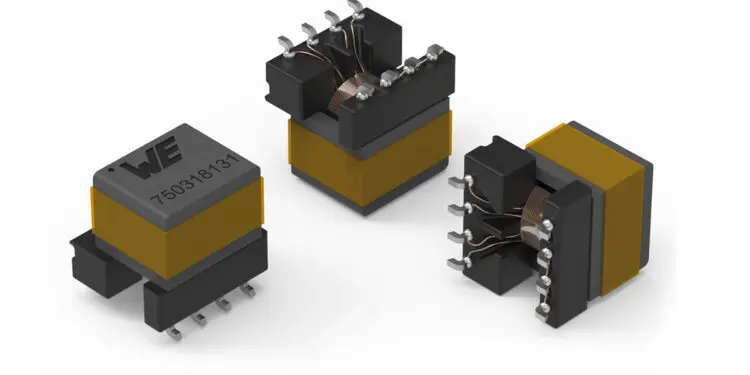The WE-AGDT series makes a new SMT assembly transformer available, which, at the same time, is part of a power supply solution developed by Würth Elektronik for demanding gate control of SiC MOSFETs.
The innovative WE-AGDT is a compact transformer in an EP7 package. It features a wide input voltage range from 9 to 36 V, a high saturation current of 4.5 A, as well as very low leakage inductance, and a very low capacitance of 6.8 pF between the windings. This gives rise to high common-mode transient immunity (CMTI) of the gate driver system.
The WE-AGDT series comprises six transformers, each optimized for its respective reference design. Thanks to their two separate secondary windings, they allow both bipolar (+15 V, -4 V) and unipolar (+15 V to +20 V, 0 V) output voltages.
The input voltage of 9 to 36 V achieves a maximum output power of 3 to 6 W. WE-AGDT transformers are optimized for SiC applications, but are also suitable for optimally controlling IGBT and power MOSFETs, and, given a suitable DC-DC converter, even for high-voltage GaN FETs. Würth Elektronik’s reference design for a compact, galvanically isolated DC-DC converter for SiC MOSFET gate drivers is available at www.we-online.com/RD001.
WE-AGDT – Auxiliary Gate Drive Transformer
“With the increasing spread of power semiconductor devices in silicon carbide technology, which work at switching frequencies above 100 kHz, their gate control requirements are becoming more and more sophisticated. With the WE-AGDT series and the associated reference design, we have developed a solution that is as innovative as it is reliable, allowing developers to easily implement a compact, efficient and flexible supply with up to 6 W output power,” says Eleazar Falco, Application Engineer at Würth Elektronik eiSos.
WE-AGDT is available from stock without a minimum order quantity. On request, free samples are made available to developers.
































